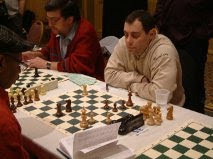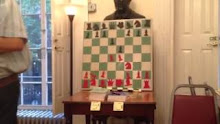Today, some 45 years later*, this assessment is still a correct one. The Marshall Attack continues to be played at the grandmaster level, as can be seen in the games of Geller and Nunn to follow.
As I did in a previous article on the Sicilian Dragon, I have taken the liberty of using Robert Byrne's annotations from his column in The New York Times, for illustrative games one through three. In illustrative game four, I have made use of the winner's notes, to be found in New in Chess Yearbook #6.
The psychological frame of mind, needed by the players of the black pieces in these games, was best described by Marshall himself in My Fifty Years of Chess: "I have always liked a wide open game and tried to knock out my opponent with a checkmate as quickly as possible. I subscribe to the old belief that offense is the best defense."
Illustrative Game One
Braga-Geller, Amsterdam 1986
1.e4 e5 2.Nf3 Nc6 3.Bb5 a6 4.Ba4 Nf6 5.O-O Be7 6.Re1 b5 7.Bb3 O-O 8.c3 d5 9.exd5 Nxd5 10.Nxe5 Nxe5 11.Rxe5 c6 12.g3 Bf6 13.Re1 c5 14.d4 Bb7!?
This is an attempt to improve upon 14...cxd4? 15.cxd4 Bb7 16.Nc3 Nxc3 17.bxc3 Qd7 18.Bb2 +/=, Matanovic-Geller, Sousse Interzonal 1967.
15.dxc5 Re8 16.Nd2
But not 16.Rxe8+ Qxe8 17.Bxd5? Rd8 18.Be3 Qe4! 19.Nd2 (19.Bxe4 Rxd1+ 20.Kg2 Bxe4+ 21.f3 Rxb1) Qxd5 20.f3 Bg5! 21.Bxg5 Qxg5.
16...Nxc3! 17.bxc3 Bxc3 18.c6 Bxc6 19.Rxe8+ Qxe8 20.Rb1 Rd8 21.Qc2
If instead 21.Rb2 a5! 22.Rc2 Qe4! 23.Qf3 (23.f3 Qd4+ 24.Kg2 a4 25.Rxc3 Qxc3 26.Bc2 Bxf3+! 27.Qxf3 Qxc2) Qxf3 (23...Qe1+ 24.Kg2 Bxf3+ 25.Nxf3 Qe7 26.Rxc3 unclear; or 23...Qe1+ 24.Kg2 Rxd2! 25.Bxd2!) 24.Nxf3 Rd1+ 25.Kg2 Rd3! 26.Be3 a4 27.Rxc3 Rxc3 28.Bd1 Ra3 -+.
21...Bxd2 22.Bxd2 Be4 23.Bxf7+ Kxf7 24.Qb3+ Bd5 25.Qb4 Qe4 26.Qxe4 Bxe4 27.Rb2 Rd4 28.h3 Bd5 29.Rc2 Ra4 30.Rc7+ Ke6 31.g4
Bad is 31.Rxg7? Rxa2 31.Be1 Ra1 32.Kf1 Bc4+.
31...Rxa2 32.Be3 b4 33.Bd4 g5 34.Rxh7 Rd2 35.Bh8 Rd1+ 36.Kh2 Rh1+ 37.Kg3 Rg1+ 38.Kh2 Rg2+ 39.Kh1 Rxg4+ 40.Kh2 Rh4! 41.Rxh4 gxh4 42.f4 a5, White resigns.
Illustrative Game Two
Belyavsky-Malaniuk, USSR Championship 1987
1.e4 e5 2.Nf3 Nc6 3.Bb5 a6 4.Ba4 Nf6 5.O-O Be7 6.Re1 b5 7.Bb3 O-O 8.c3 d5 9.exd5 Nxd5 10.Nxe5 Nxe5 11.Rxe5 c6 12.d4 Bd6 13.Re2 Qh4 14.g3 Qh5 15.Nd2 Bh3
Or 15...Bg4 16.f3 Bxf3 17.Nxf3 Qxf3 18.Rf2 Qxd1+ 19.Bxd1 Rae8 20.Bf3 +/=.
16.f3 Bc7 17.Ne4 Rae8
If 17...Qxf3, then 18.Ng5 Qh5 19.Nxh3 Qxh3 20.Qf1 +/=.
18.Qd3!? Re6 19.Bd2 Rg6 20.g4!? Bxg4!?
Alternatives are:
a) 20...f5 21.Ng3! Bxg3 (21...Qh4 22.Nxf5) 22.hxg3! (22.gxh5?! Bf2+ 23.Kxf2 Rg2+ 24.Kf1 Rg3+ 25.Kf2 Rg2+ 26.Kf1 Rg3+ 27.Rg2?! Rxg2 28.Qe3!? f4 29.Qe7 Rxd2+ 30.Kg1 h6 unclear) fxg4 23.Re5! Rxf3 24.Qe4! Rxg3+ 25.Kh2 Qh4 26.Bxd5+ cxd5 27.Qxd5+ Kf8 28.Qa8+ Kf7 29.Qe8+ Kf6 30.Qe7#;
b) 20...Qh4 21.Be1 Qd8 22.Bxd5 cxd5 23.Ng3 Bxg3 24.Bxg3 f5 25.gxf5 Bxf5 +/=.
21.fxg4 Rxg4+ 22.Ng3 f5 23.Rg2 Qh3 24.Rf1! Rf6
White answers 24...f4 with 25.Qe4!.
25.Rf3 h5
Now 25...f4 is met by 26.Qe2! fxg3? 27.Qe8+.
26.Qe2 Rfg6 27.Bc2, Black resigns.
* * * * * * * * * * * * * *
Illustrative Game Three
Ljubojevic-Nunn, Szirak Interzonal 1987
1.e4 e5 2.Nf3 Nc6 3.Bb5 a6 4.Ba4 Nf6 5.O-O Be7 6.Re1 b5 7.Bb3 O-O 8.c3 d5 9.exd5 Nxd5 10.Nxe5 Nxe5 11.Rxe5 c6 12.d4 Bd6 13.Re2 Qh4 14.g3 Qh3!? 15.Nd2
The alternative is 15.Qf1 Qh5 16.f3 Bh3 17.Qf2 Rae8 18.Nd2 f5.
15...Bf5 16.Bc2
White must avoid:
a) 16.Ne4? Bg4 17.Nxd6 Qh5 18.Kf1 Qxh2 19.f3 Bh3+ 20.Ke1 Qxg3+ -/+;
b) 16.Bxd5 cxd5 17.f3 Rae8 18.Nf1 h5 19.Be3 h4 20.Bf2 Bd7 21.gxh4 Rxe2 22.Qxe2 Re8 23.Qd3 Re6 24.Bg3 Rg6 25.Kf2 b4 -/+, Gruenfeld-Pinter, Zagreb Interzonal 1987.
16...Bxc2 17.Qxc2 f5 18.c4
If 18.f4, then 18...Qf4 19.Nf1 Bxf4.
18...Qg4! 19.Re6!
Worse is 19.Re1 f4! 20.f3 Qh3 21.cxd5 fxg3 =/+, Mokry-Panczyk, Zdroj 1984.
19...Nf4! 20.Rxd6?
Correct is 20.f3 Nh3+ 21.Kg2 Nf4+ 22.Kg1 Nh3+ =, Hubner-Timman, Tilburg 1987.
20...Rae8 21.cxb5
No better is 21.Nf3 Re2 22.Qb3 Nh3+ 23.Kh1 Rxf2 24.cxb5+ Kh8 25.Bf4 Rxf3 26.Qf7!? Rg8 27.Re1 Rxf4! -/+.
21...Re2!
Wrong is 21...Re1+? 22.Nf1 Qh3 23.Qc4+ Kh8 24.Bxf4 +/-.
22.Qc4+
The move 22.Qxc6? fails to 22...Re1+ 23.Nf1 Rxf1+! 24.Kxf1 Qd1#. Also unavailing for White is 22.Qb3+ Kh8 23.Nf3? Qxf3!.
22...Kh8 23.Qxe2
On 23.d5, there is 23...Re1+ 24.Nf1 Ne2+.
23...Nxe2+ 24.Kg2 f4! 25.bxc6
A pretty finish would be 25.f3 fxg3! 26.fxg4 Rf2+ 27.Kh3 Rxh2#.
25...fxg3 26.hxg3 Nf4+, White resigns.
* * * * * * * * * * * * * *
Illustrative Game Four
Ulmanis-Van der Heijden, Correspondence 1985
1.e4 e5 2.Nf3 Nc6 3.Bb5 a6 4.Ba4 Nf6 5.O-O Be7 6.Re1 b5 7.Bb3 O-O 8.c3 d5 9.exd5 Nxd5 10.Nxe5 Nxe5 11.Rxe5 c6 12.d4 Bd6 13.Re1 Qh4 14.g3 Qh3 15.Be3 Bg4 16.Qd3 Rae8 17.Nd2 f5 18.f4 Kh8 19.Bxd5 cxd5 20.Qf1 Qh5 21.a4 bxa4
Another sharp line is 21...g5 22.axb5 axb5 23.fxg5 Rxe3 24.Rxe3 f4 25.gxf4 Bxf4 26.Rg3 Qxg5 27.Kh1 Bd6 28.Qe1! (28.Qg2 Bxg3 29.Qxg3 h5 30.Ra7 h4 -/+) Bxg3 29.hxg3! Qh5+ 30.Kg1 Re8 31.Qf2 Re2?? 32.Qf8#.
22.Rxa4 g5 23.fxg5?!
White should play 23.Raa1!.
23...Rxe3 24.Rxe3 f4 25.gxf4 Bxf4 26.Rg3 Qe8!
Inferior is 26...Be3+ 27.Rxe3 Rxf1+ 28.Nxf1.
27.Rxg4 Be3+
Less convincing is 27...Bxd2 28.Qxa6 Qe1+ [28...Qh5 29.Qe2! Be3+ 30.Kh1 Rf2 31.Ra8+ Kg7 32.Ra7+ Kf8 (32...Kg6 33.Qd3+!) 33.Ra8+ =] 29.Kg2 Rf2+ (29...Qd1 30.Rg3 Be1 31.Ra1! Rf2+ 32.Kg1!) 30.Kh3 Rf3+ 31.Rg3 Rxg3+ 32.hxg3 Qh1+ 33.Kg4 Qe4+ 34.Kh5 Qh1+ =.
28.Kg2
After 28.Kh1, Black plays 28...Rxf1+ 29.Nxf1 Qxa4 30.Nxe3 Qa1+ followed by 31...Qxb2 and the advance of the a-pawn.
28...Rxf1 29.Nxf1 Bc1!
White has better chances of defending after 29...Qxa4 30.Nxe3 Qb3 31.Kf3!? Qxb2 32.Nxd5 Qxh2!? 33.Re4 and 34.Re5.
30.Ra5
White rejected 30.Rb4 on account of 30...Qe2+ 31.Kg3 Qxf1 32.Rb8+ Kg7 33.Rb7+ Kg8 34.Rb8+ Kf7 35.Rb6 Qd3+ 36.Kh4!? Bd2 37.Rf6+? Kg7 38.Kh5 Be1! 39.h4 Qg6+ 40.Rxg6+ hxg6#.
30...Qe2+ 31.Kg3 Qxf1 32.Rxd5 Bd2!?
Black might also have tried 32...Be3 33.Re4 Qf2+ (33...Qd3?? 34.Rd8+ Kg7 35.Re7+ Kg6 36.Rg8+Kf5 37.Re5#) 34.Kg4 Qg2+ 35.Kf5 Qxg5+ (35...Qf3+ 36.Ke5 Bxg5 37.Rd6) 36.Ke6 Qg6+ 37.Ke5 Bg1 38.Rd8+ Kg7 39.Rd7+ Kf8 40.Rf4+ (40.Rd8+ Ke7 41.Ra8 Qg5#) Ke8 41.Rff7 Bxh2+ followed by 42...Qxf7 -/+.
33.h4?
White could have put up more resistance by 33.h3 [33.Rd8+ Kg7 34.h4 (34.h3 Be3! 35.Re4 Qf2+ 36.Kg4 Qg2+ 37.Kf5 Qxg5+) Be1+ 35.Kh2 Qf3! 36.Rg2 Qf4+ 37.Kg1 (37.Kh1 Bg3) Bd2! 38.Re2 Be3+ 39.Kg2 Qg4+ 40.Kf1 Qg1#] Be1+ (33...Qg1+ 34.Kf3 Qh1+ 35.Ke2 Qxd5 36.Kxd2 Qf3!) 34.Kh2 Qf2+ 35.Rg2 Qf4+ 36.Kg1 Bd2 37.Re5 Be3+ 38.Rxe3 Qxe3+ 39.Kh2 Qf4+ 40.Kg1 Kg7 -/+.
33...Qg1+ 34.Kf3 Qh1+ 35.Rg2 Qh3+ 36.Rg3 Qf1+ 37.Kg4 Qf4+ 38.Kh3 Be1, White resigns.
*{This article originally appeared in Atlantic Chess News in 1988}




























